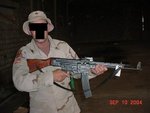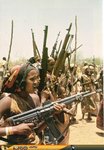- Thread starter
- #81
The original StG44 manual is my source Parsifal:

Translation:
4. Firing distance:
Aimed fire: 100 to 800 m. Adjustable in 100 m increments.
Effective range: In singleshot mode 600 m
......................In automatic mode 300 m
5. Firing rate:
9 rounds/sec (540 rpm)
6. Mass and weight:
Caliber: 7.92mm
Lenght: 930mm
Weight with sling magazine: 4.62 kg
Weight of 30 round full magazine: 0.92 kg
Each 7.92x33mm Kurz round weighs 16.5 grams (8.1 g projectile 8.4 g cartridge filling), and there's 30 of them in the mag, which equals 495 grams. Add that to the 4.62 kg and you've got the full weight = 5.11 kg. So your source got one thing wrong Parsifal, the weight of 5.1 kg wasn't unloaded but instead fully loaded.
Translation:
4. Firing distance:
Aimed fire: 100 to 800 m. Adjustable in 100 m increments.
Effective range: In singleshot mode 600 m
......................In automatic mode 300 m
5. Firing rate:
9 rounds/sec (540 rpm)
6. Mass and weight:
Caliber: 7.92mm
Lenght: 930mm
Weight with sling magazine: 4.62 kg
Weight of 30 round full magazine: 0.92 kg
Each 7.92x33mm Kurz round weighs 16.5 grams (8.1 g projectile 8.4 g cartridge filling), and there's 30 of them in the mag, which equals 495 grams. Add that to the 4.62 kg and you've got the full weight = 5.11 kg. So your source got one thing wrong Parsifal, the weight of 5.1 kg wasn't unloaded but instead fully loaded.
Last edited:



